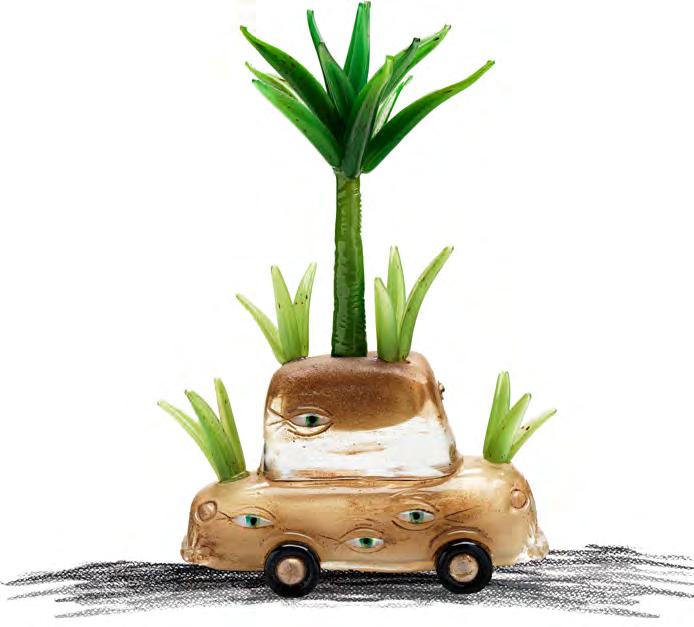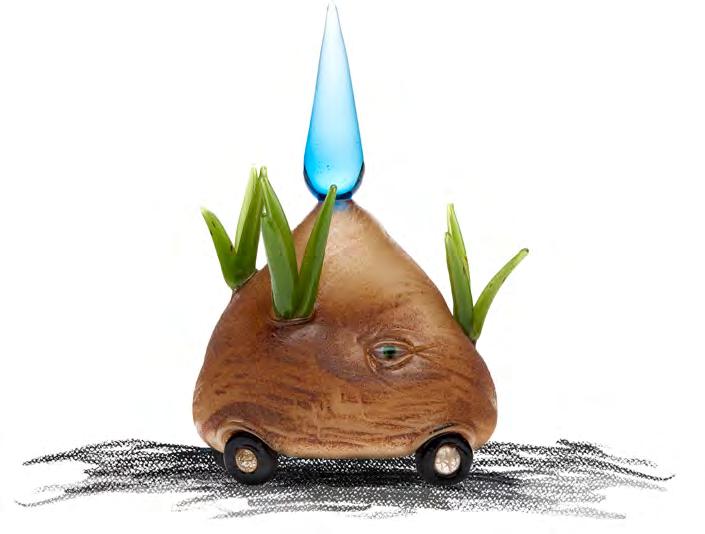
Publisher
Gallery Services
Gallery Services, Townsville City Council
PO Box 1268
Townsville Queensland, 4810 Australia
ptrg@townsville.qld.gov.au
©Gallery Services, Townsville City Council and the authors 2016
ISBN: 978-0-949461-18-6
Organised by Gallery Services
Shane Fitzgerald Manager Gallery Services
Eric Nash Curator
Erwin Cruz Exhibitions and Collection Coordinator
Louise Cummins Education and Programs Coordinator
Rob Donaldson Digital Media and Exhibition Design Coordinator
Jo Stacey Team Leader Administration Gallery Services
Holly Grech-Fitzgerald Collections Management Officer
Carly Sheil Digital Media and Exhibition Design Officer
Leonardo Valero Exhibitions Officer
Rurik Henry Exhibitions Officer
Sarah Welch Public Art Officer
Jess Cuddihy Education and Programs Officer
Sarah Reddington Education and Programs Assistant
Danielle Berry Arts Officer
Wendy Bainbridge Administration Officer
Ruth Hughes Administration Officer
Jillian Macfie Gallery Assistant
Jo Lankester Gallery Assistant
Damian Cumner Gallery Assistant
Nicole Richardson Gallery Assistant
Samuel Smith Gallery Assistant
Tom Moore
Tree Feet 2009

Hot joined, blown and solid glass 33 x 23 x 13 cm
Contact
Perc Tucker Regional Gallery
Cnr Flinders and Denham St
Townsville QLD 4810
Mon - Fri: 10am - 5pm
Sat - Sun: 10am - 2pm
Published on the occasion of
(07) 4727 9011
ptrg@townsville.qld.gov.au
www.townsville.qld.gov.au
@TCC_PercTucker
PercTuckerTCC
Perc Tucker Regional Gallery
26 August - 23 October 2016
Project Manager
Shane Fitzgerald
Contributing Authors
Shane Fitzgerald / Tom Moore / Eric Nash
Publication Design and Development
Carly Sheil
Acknowledgements
Gallery Services would like to acknowledge Tom and Rosie Moore for their efforts in assisting us realise this exhibition, the generous support of Glencore for their ongoing support of the Annual Children’s Exhibition through the Glencore Community Program North Queensland with special thanks to Avril Plath, Community Relations Glencore, and Townsville City Council for its ongoing support of Perc Tucker Regional Gallery.
Perching proudly upon its catch, Prehistoric Prank resembles an eager terrier looking for praise.
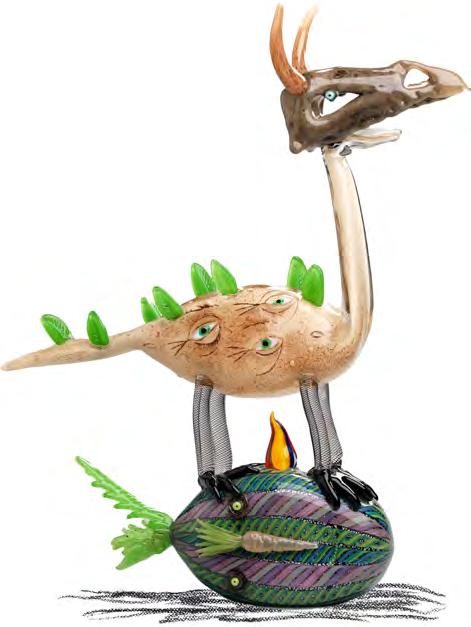
This prey has a formidable self-defence mechanism –spontaneous combustion.

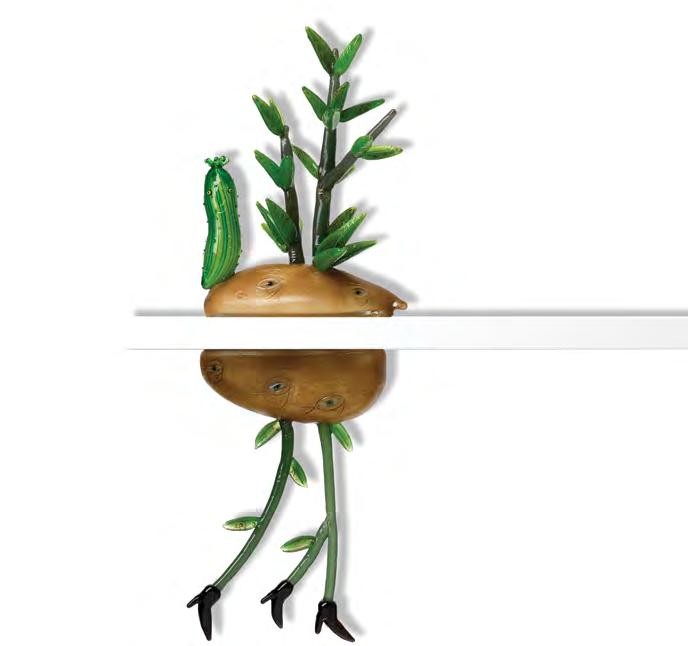
Flying Potato Car is an example of profound adaptation.

The struggle for self-preservation has inspired this tasty root-vegetable to generate both a set of swift wheels and a pair of marvellously efficient wings.
The profusion of open eyes indicates that this specimen is currently in a state of utmost vigilance.
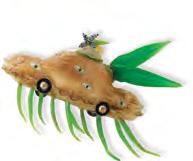


Glass is a kind of metaphor for the history of human industry.
Glass has enabled technological social and aesthetic benefits.
Unfortunately, glassmaking also contributes to climate change and environmental degradation.
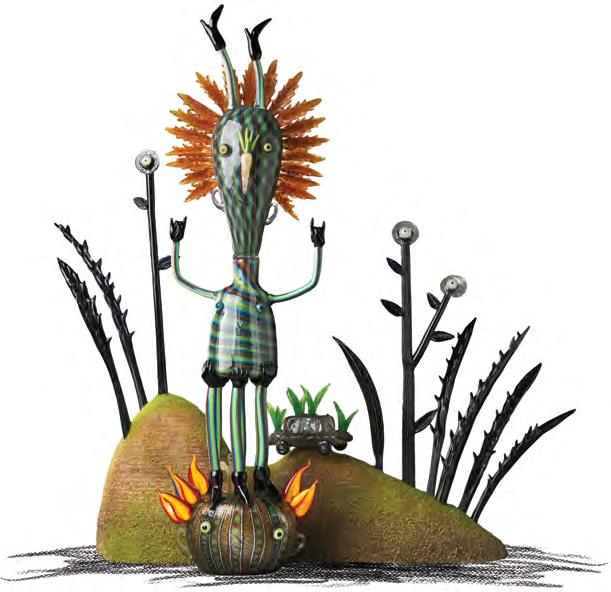
Perhaps the inherent problem of continuing to use this material to raise themes of environmental peril can add to the impact of the objects.
The car is perched atop a hill and sprouting plants, it sits on a bearing and will spin if you push it. It is fanciful and futile.
The application of eyes onto plants suggests the possibility of the sentience and agency of nature. They watch us as we watch them and hold us accountable.
All of this is tempered by precise technical flights of fancy and the desire to surprise.

Metamorphosis is a biological process by which an animal physically develops after birth or hatching, involving a conspicuous and relatively abrupt change in the animal’s body structure through cell growth and differentiation.

In Tom Moore’s work, we can see this metamorphosis has played out in unnatural fashion, and is perhaps not at its end point. His characters have figurative and animalistic elements, bloom with flowers, trees and shrubbery, and contain vehicular and mechanical features. Moore wants to shock and delight us with the incongruity of his imagination. Moore’s work is a surprise not only to his viewers, but also a jolt to the glass medium.
He has mastered glass techniques dating back to 13th century Venice, but his application of those techniques and his willingness to embrace technology allows him to present something that is as cutting-edge as it is steeped in tradition. In this, his most recent major exhibition, Tom Moore presents a series of beautiful creatures and scenes that allow young and old audiences alike to admire, laugh, and learn.
The centrepiece to the exhibition is Watt’s Triumph, which has not been publicly displayed previously. This piece displays, Moore states, “…formal and decorative links to ancient traditions while simultaneously offering a narrative engaging with contemporary concerns.
The plants adapt chandelier-making processes; the figure is a bottle and stopper, representing an aspirational inventor.”
“This work springs from a joy in the spirit of innovation and technological ambition, tempered by a sense of dread arising from the emerging knowledge of the possible consequences.” I am positive that audiences to Metamorphosis will identify the joy and love with which all of Moore’s characters have been created, and also take time to reflect on the themes that underpin their creation; primarily the environment, but also an engagement with absurdist literature and narrative. I want to convey the deepest gratitude of Perc Tucker Regional Gallery to the artist Tom Moore, and his wife Rosie, for their assistance in realising this exhibition.
I would also like to acknowledge the ongoing support of Glencore, who began supporting an Annual Children’s Exhibition over ten years ago. Glencore share Perc Tucker Regional Gallery’s vision for the engagement of Townsville’s young citizens with art and exceptional creative learning opportunities. Exhibitions such as this, the 2016 Glencore Children’s Exhibition, would not be possible without the support of our generous partner.
Shane Fitzgerald Manager, Gallery ServicesIt may be that the desire to amalgamate characteristics of people, plants, animals and machines has its most elegant resolution in the form of the PotatoFishCar.

King Flame Fish is a character that speaks about the interconnectedness of all life and the assimilation of technology in a neat package.
The crown evokes medieval carnivals when established social hierarchies were temporarily inverted: a fool was crowned as the king.
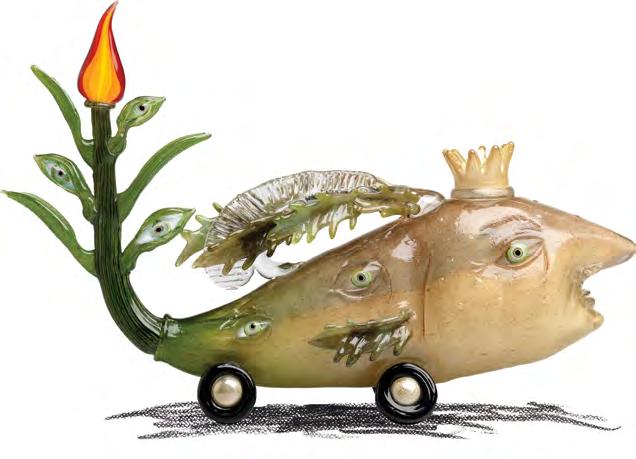
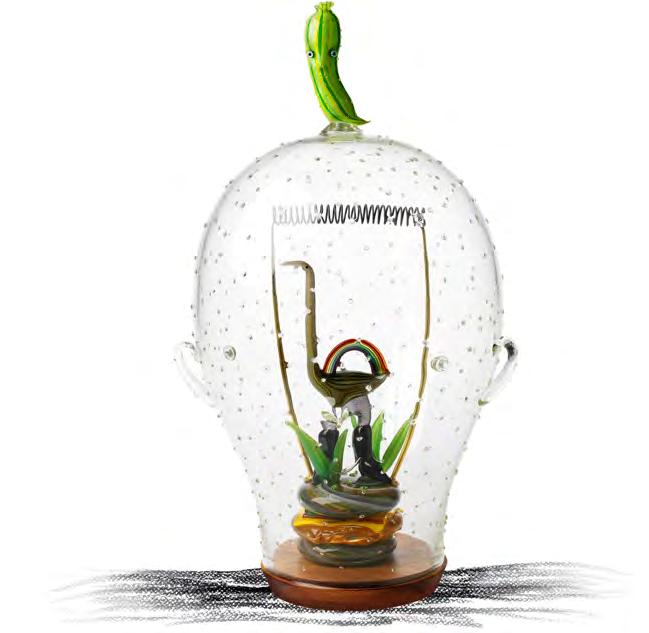

“I identify very strongly as a craftsperson, and I feel like I am continuing a very ancient tradition. “
- Tom Moore
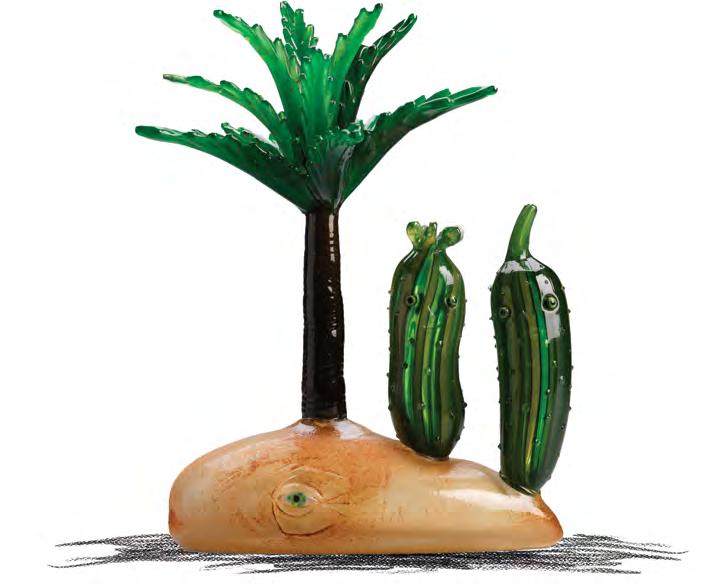
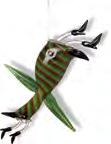

In terms of glass-making a flask is surprisingly similar to a water-fowl. For a glassblower flying ducks may seem like bottles bobbing sideways in the air.

When stretching the molten vessel, adjusting the proportions of neck to body can produce a change in avian taxonomy from swan to coot.
This stacked family of birds share similarities of form but display very different surface characteristics. The cyborg below tows a trailer containing an allseeing granite block.
A drop of fossilised rain nourishes the healthy display of leafy branches sprouting from this attentive rock.

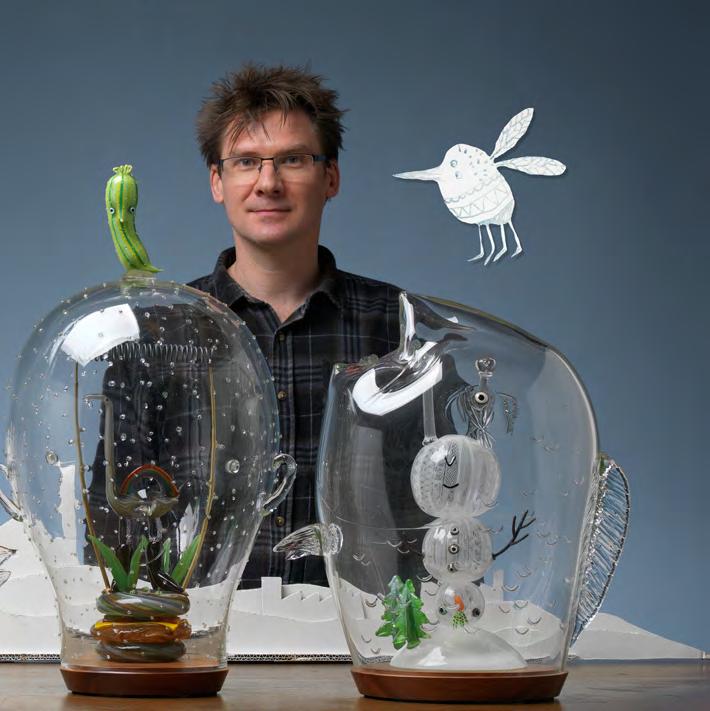
I am extremely pleased to be exhibiting at Perc Tucker Regional Gallery for the 2016 Glencore Children’s Exhibition and with strong links to the Gallery’s Creative Classrooms education program. One of the most gratifying effects of doing creative work is when I see kids are engaging with the ideas and building upon these in their own inventive ways.
I know that the imagination can be fed. Much of this work arises from the strange and delightful illustrations I saw as a child. These images cross-pollinated and began to grow with hybrid vigour! The nonsense literature of Edward Lear, Lewis Carroll and Doctor Seuss continue to inspire me toward the creation of visual humour in glass.
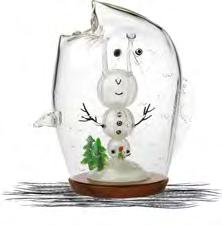
Having grown-up in Canberra, I am excited by the comparative strangeness of the tropics. I am inspired by the abundance and variety of life here and this has had a direct effect on some of my works.
It is sweet to be having a solo exhibition in Townsville as I have developed a personal connection with the place through marriage. I have visited fairly regularly for over a decade. My wife Rosie’s parents live a little further north but they met in Townsville and we enjoy returning to see Super-Gran.
Rosie is indispensable to my art-practice, handling much of the business side of things, packing and helping with installation.
I am grateful for her ongoing support, frequent patience and occasional necessary impatience. Glass has a long history as a vehicle for articulating wonder.
Italian renaissance appetites for novelty, rarity and luxury led to patronage for courtly artists and proto-scientists. Court artists were employed to supply craftspeople with drawings that would extend their range beyond way beyond conventional forms. The items produced in these workshops were often based on drinking glasses. However, they were often barely usable, intentionally subverting function.
These objects were designed to serve a different function of inspiring wonder and amusement. The princes commissioning and collecting these items were also amassing vast collections of curiosities including anomalous and rare natural specimens and objects that blurred the boundaries between the realms of art and nature.
Glassworkers were closely aligned with alchemists who took an interest in the process because of its metamorphosis of materials. Glass recipes were improved by alchemists to the benefit of glass-blowers, who consequently made the apparatus that was crucial the alchemist laboratory.
Glass is created from common materials, transformed through fire into a state of liquefaction. Once cooled, it is an amorphous solid that still appears liquid.
The material of glass is something of a paradox, as it is extremely durable yet brittle. The transparency of clear glass allows it to be simultaneously “there” and “not there”. An accomplished glass chemist is able to make an infinite number of transparent, translucent or opaque colours and in the hands of a skilled worker these can be used to imitate various other materials such as precious gems, plants and eyes. Patterns of different colours can be twisted and stretched to achieve minute detail. Glass can be remelted and readily joined. Complex assemblages can be made from multiple elements.
The coloured glass used to make these objects was formulated and melted by Gaffer Glass Company in New Zealand. The recipe for the clear glass was developed by the same company. The clear and coloured glasses are designed to be compatible with each other by having very similar thermal expansion rates. Glass is fussy about what it will stick to.
Glass was traditionally produced by teams of workers, each doing a part of the process to make multiple similar items. The works in this exhibition are all produced with at least one assistant, the complex works need 2 assistants and the largest pieces of glass require 4 assistants.
The techniques used in this exhibition are based upon Venetian glassmaking traditions. For hundreds of years these techniques were closely guarded secrets. Since the mid 1980s several Venetian Maestros have generously shared these processes. This has given the studio glass movement a technical vocabulary and sophistication that has motivated diverse individual expression with glass.
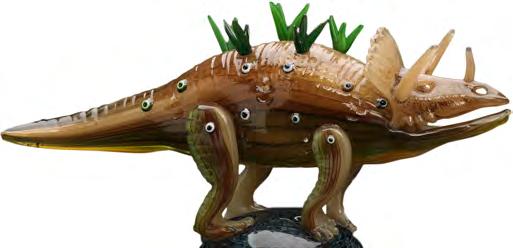
The vibrant colours of Spinosaurus Dad are achieved by layering twisted rods of transparent colour over silver-leaf.
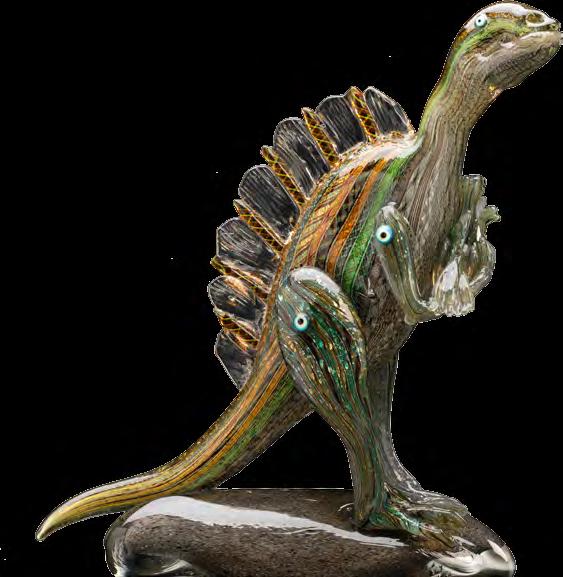
The silver reflects light through the colour as if lit from within.
This sparkly transmitted light has a different quality to the reflected light of opaque objects.
The offspring of this proud and protective father has the tail of a bird.
Could this be the result of fast-tracked evolution or a dalliance with a winged creature?

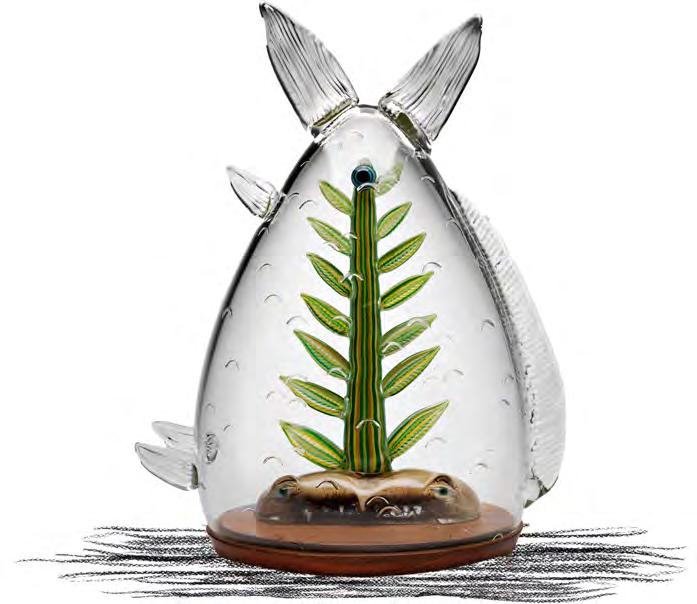
Glassworkers were closely aligned with alchemists who took an interest in the process because of its metamorphosis of materials.Tom Moore Sapling Spine 2014 Hot joined blown and solid glass, wooden base 50 x
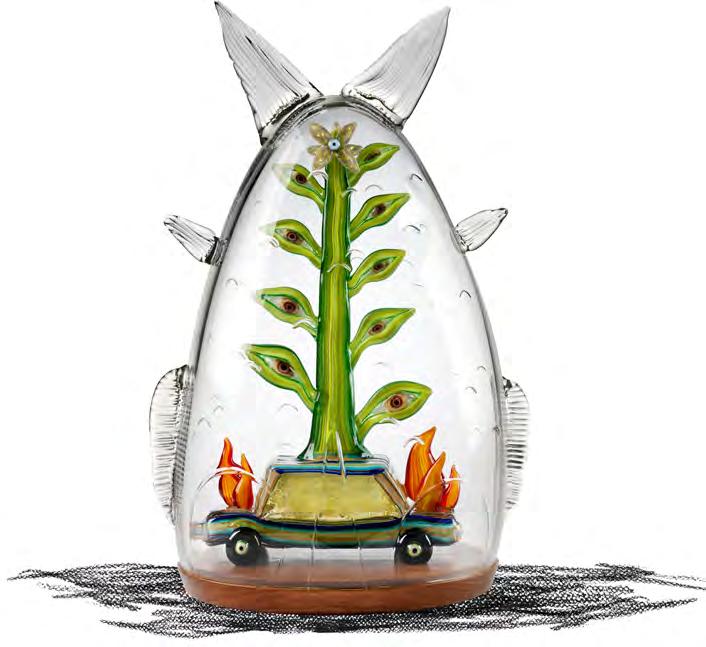

I am particularly interested in exploring the relationships of humans and nature. As a child I was drawn to Edward Lear because of the images depicting people appearing like, behaving like or being inhabited by animals. More recently I have developed a fascination with hybrid combinations of people, plants, animals, minerals and machines.
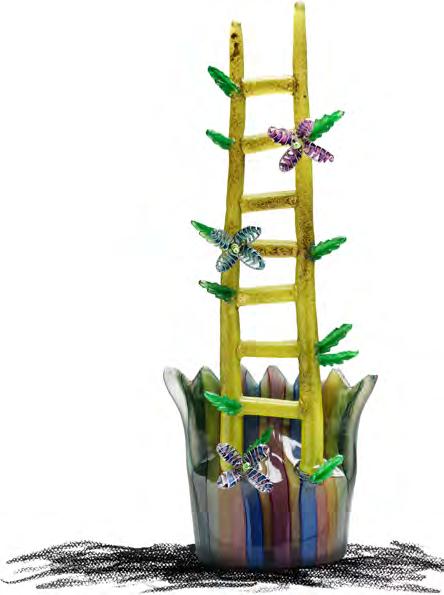
My aspirations as a visual communicator utilising biological imagery spurs a moral imperative to address the current state of the planet that is increasingly affected by human activity to the detriment of biological diversity. I think it is important to acknowledge my complicity in environmental damage in my daily and working life. This is particularly pertinent due to the resource intensive and greenhouse gas producing nature of glass blowing. I believe I need to endeavour to make these objects worthy of being made. I realise that if I am to continue making glass into the future I will need to find other ways of offsetting the problems I create. Growing trees and other carbon offsetting can certainly help with that.
My motivation for making is to see and share things that have never been seen before. I am seeking the unexpected. With luck, objects with this power can be created through the combination of incongruous elements. Much like a surprising joke, viewing these objects can induce a cognitive shift that feels like a pleasant shock. I am trying to make things that are odd enough to cause my brain to stand on its head. This can allow me to reassess assumptions that I had thought were fixed. In a state of joyful confusion it might be possible to sidestep impossibility.
While foraging underwater for tasty invertebrates, this duck has swallowed a magic bean and her legs transmuted into a living ladder.

A wrecked sports-car entangled with kelp is left teetering, stranded at the top of a bell-curve by the receding water.
Seen another way, a head emerges with tired eyes. This form contains a bitumen fire.

Image top
Tom Moore
Flying High 2008

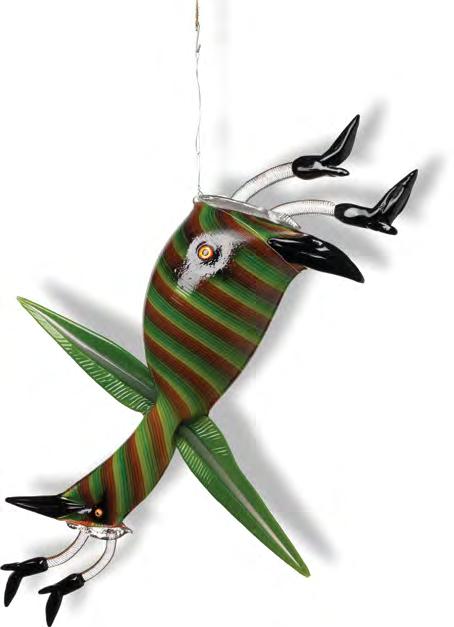
Hot joined, blown and solid glass, mixed media
50 x 40 x 9 cm
Image bottom

Tom Moore
Fat Head 2008
Hot joined, blown and solid glass, mixed media
67 x 36 x 11 cm
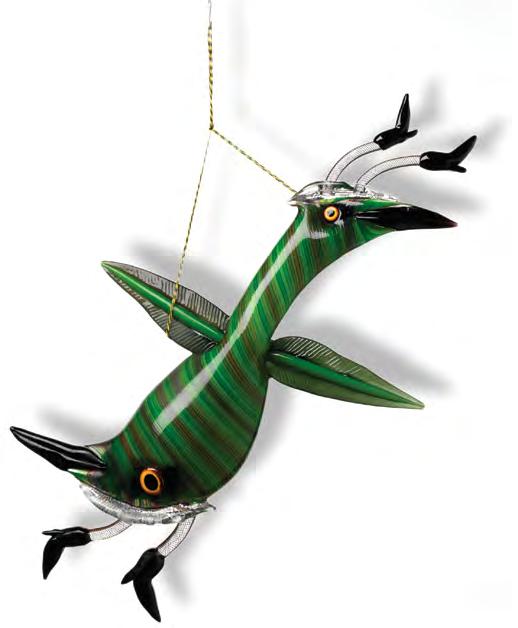

“I am not interested in presenting depictions of nature that are simply beautiful.”
- Tom Moore
Hotted Up Potato is a delicious specimen

– if
you are fast enough to catch it!

–
The Mechanic waits with baited breath, poised atop her carriage.
Tom Moore once commented that his characters “are trying to make sense of a complicated and nonsensical world.” 1
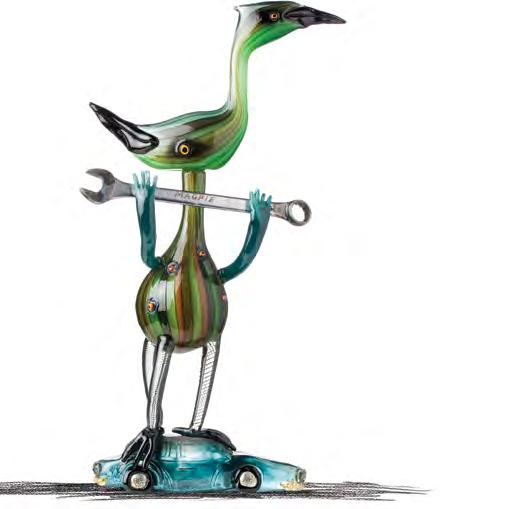
Viewers can probably identify with Moore’s characters now more than ever, as we are similarly met with a seemingly unending series of environmental and human rights travesties, and social, political and economic upheaval consistently played out for global audiences.
Fortunately for Moore’s characters, they don’t reside solely in our uncertain and scarred world, but equally in a universe of pure imagination. It is a place of the absurd, surprising, hilarious and beautiful that Moore invites his viewers to also enter. The world he has built for his characters provides us with an escape. However, it is just that – a temporary escape – and therefore also a timely reminder of the impact we are having here in our reality.
She lives in hope and anticipation that a creature will break down nearby so she might perform astonishing repair skills diligently absorbed via school of the air.
Most poignantly, his characters, which are seemingly impossible amalgams of people, plants and machines, call attention to the very real impact we are having on the environment. Moore commented;
“We live in a time of unprecedented awareness of the relationships between life forms and global systems. Smart people are trying to understand what is going on. At this juncture it is pretty clear that there is trouble in paradise. Consequently, I am not interested in presenting depictions of nature that are simply beautiful.”

Robot Bird Triumphant Again arises from a fun-loving apocalyptic fantasy of giant birds joyriding on top of cars.
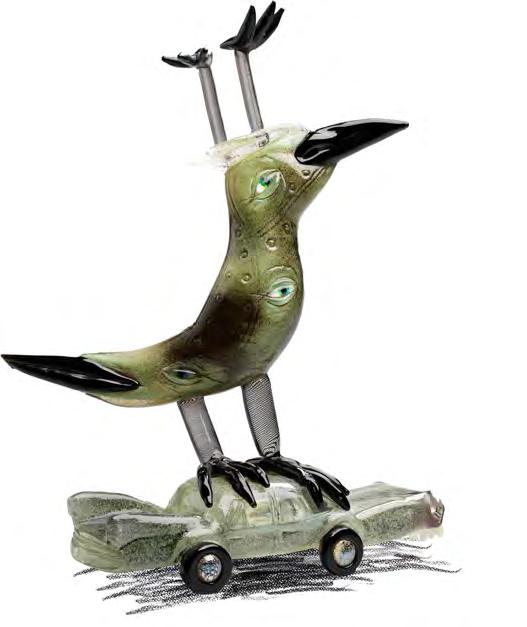
The bird on the car is intended as a hopeful symbol of the triumph of nature over industry.
However, the current incarnation is perplexing and exceptional.
This is a palindrome-bird. The body is a second head, the tail a second beak, a second pair of legs extend above.
This bird appears to be mechanical, constructed of riveted metal plates.
The car seems more organic than the passenger.
With tail-fins and comical teeth, it may have freshly emerged from primordial sludge.
“I like the idea of sentient plants and rocks. I stick eyes all over plants because I want to feel like they are watching us –perhaps they are holding us accountable for the stuff we do that messes up the planet.” 2
Moore’s characters should hold us accountable, too, as they’ve clearly been impacted by our choices. Cars have sprouted trees and grown eyes (and consciousness in a terrifying Terminator-esque twist!); legs protrude from the heads of upside-down birds; flames shoot from a plant, which is actually the tail of a mutant fish. Creatures have multiple faces and seemingly split personalities. These are simultaneously familiar and unfamiliar creatures from a world in flux, demanding constant adaptation and dramatic metamorphoses to survive. The natural order of things appears to have been lost, and it’s easy to see why Moore’s characters are struggling to make sense of their world.

In reality, what is ‘natural order’ these days, anyway? It seems with each technological advance, particularly with respect to travel and communication, our world has become more connected; paradoxically, we’ve become less connected with our world, and so even if we did know what ‘natural order’ was, it’s unlikely we’d respect or preserve it.
For this reason, Moore’s characters can also be viewed as metaphors for our world, a living organism in its own right with great and complex systems which are all interconnected. A delicate balance must be retained for it (and presumably Moore’s characters) to grow old in good health. So what impact do we, its most volatile cells, have?
Having spent so much time secluded in its study, thinking about the philosophy of humour, Prank is caught in an infinite loop of contented self-reflection.
For a long time this was the most complicated thing I
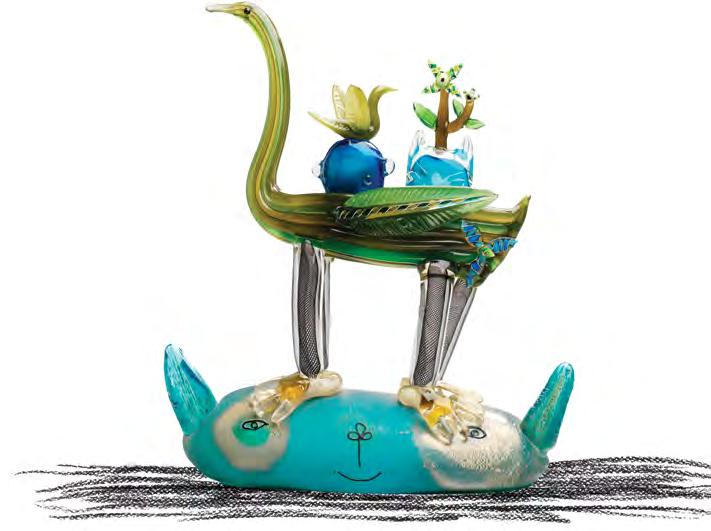
The insulating property of glass reconciles the oversized consuming fire at the core of this character with his wide-eyed wish to sustain the tender sprout at a tolerable temperature.
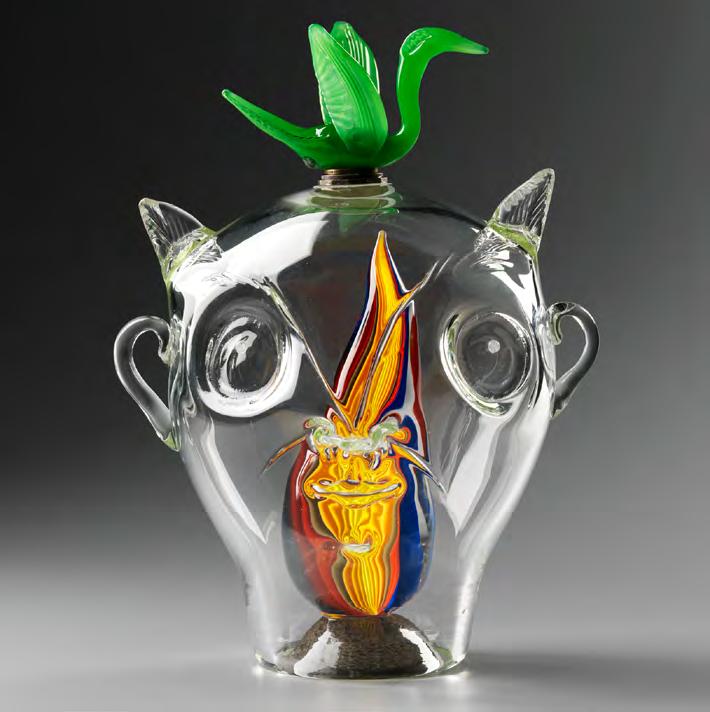 Tom Moore $1.70/Litre 2016 Hot joined solid glass, mixed media 30 x 23 x 18 cm
Tom Moore $1.70/Litre 2016 Hot joined solid glass, mixed media 30 x 23 x 18 cm
“I like the idea of sentient plants and rocks.

I stick eyes all over plants because I want to feel like they are watching us –perhaps they are holding us accountable for the stuff we do that messes up the planet.”
- Tom MoorePalm trees and emu eggs were favourites for colonial silver centrepieces.

Mechanical systems of our creation have put the world’s delicate balance in a perilous position. The obvious tension between plant, animal and mechanical here on Earth is played out in each of Moore’s characters. It beckons the question, will we recognise this tension in time, and therefore try to rediscover a ‘natural order’, or better yet put our technological and scientific advances to good use in rectifying some of the damage already done? Or will we continue to force our will, allowing our machinery to spread throughout every system, pressing other living organisms to adapt further else perish?
Quite simply, Moore concedes, “I think that if you’re going to explore the relationship of humans and nature – so humans, animals and plants – it’s sort of necessary to acknowledge the problem of human initiated environmental damage.” 3
While lamenting our impact on the environment and our co-habitants of the world, Moore posits that life – even if in an unrecognisable form – will continue. “Human activity is making life impossible for many species and may well lead to conditions that are inhospitable for ourselves, however…it will go on turning and creatures will continue to evolve.” 4
This example has transgressed polite society, springing to abundant and chaotic life.
Metamorphosis, hybrid creatures, and adaptations resulting from human interference are themes similarly explored by acclaimed Australian ceramic artist Jenny Orchard, hyperreal sculptor and media artist Patricia Piccinini, and Canadian sculptor Ellen Jewett. Parallels can even be drawn with Hieronymus Bosch’s 15th – 16th century masterpiece, The Garden of Earthly Delights, not purely for Bosch’s depiction of imagined creatures and impossible stone formations, but also as the triptych can be read as a dire warning of our indulgences leading to a scorched, uninhabitable landscape.
Octoperson (inward) 2009
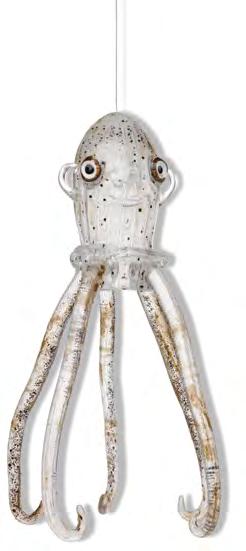
Hot joined solid glass, mixed media 33 x 17 x 18 cm

Metamorphosis: The Art of Tom Moore
Metamorphosis: The Art of Tom Moore

Octoperson (outward) 2009
Hot joined solid glass, mixed media 33 x 14 x 13 cm

While the environmental warning we must take away from Moore’s imagined world is ominous, viewing the works remains an overwhelmingly joyous experience. His creatures may be grappling with the challenges of our ever-changing world, but they exude an innocence and awkward beauty that one can’t help but smile at. It’s a particular talent of Moore’s to impart such a critically important and foreboding message without the audience necessarily being acutely aware of it, much less depressed by it, at the time of viewing.
A number of factors contribute to this ability, namely Moore’s supreme command of the glass medium and his want to push it in new directions; his deliberate use of humour and keen awareness of absurdist literature; and the boundless narrative potential of his characters.
Moore’s introduction to glass came early on in life, as he recalls viewing glass blowing for the first time at age 16. It was an experience in keeping with a childhood that exposed him to “a lot of very imaginative and inspirational stuff” and ultimately led to him drawing ‘nonsense imagery’ – precursors to his imagined characters no doubt – before entering art school. 5
Moore entered the Australian National University’s glass program in the early 1990s, an experience that he found particularly beneficial as it presented the opportunity to assimilate Venetian glass-blowing techniques, which he applied to idiosyncratic imagery.

“Lear belongs to a proud lineage of venerable buffoons – artists working throughout time and cultures, busy imagining absurd combinations of people plants animals and machines.


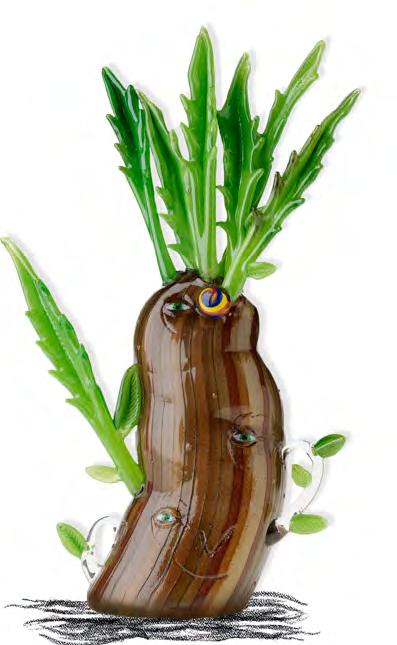
I aspire to inclusion within this company.”
- Tom MooreBranching Barracudas believe they are invisible.
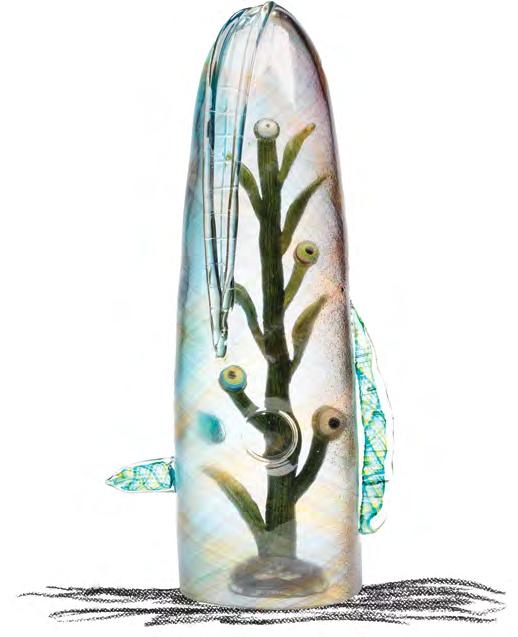
However, opaque insides and multiple eyes peering out through their transparent skin betray them.
They are a wonder of closed-branch evolution.
Following his graduation, Moore worked from 1999 to 2014 as Production Manager at JamFactory, a leading not-forprofit craft organisation based in Adelaide. Here, Moore worked on many varied products and commissions, and trained graduates in disciplined production of design and exhibition objects.
For a number of years, Moore found his practice positioned somewhat awkwardly between craft and contemporary art, seemingly fitting in neither neatly enough to appease the doyens of ‘good taste’. Despite this, he received a number of major prizes for glass-art and over time, the tide of opinion and opportunity has turned. His work is now included in many prominent public collections, and has been featured in high-profile exhibitions of contemporary art, culminating recently in his participation in Magic Object, the Art Gallery of South Australia’s major exhibition underpinning the 2016 Adelaide Biennial of Australian Art.

Though recognition from the contemporary art world has come, it has not come at the expense of Moore’s position within a lineage of traditional craft.
Rather, it has come about due to Moore’s eagerness to push the traditional bounds of the medium to resolve his ‘wonky drawings’ in glass; and as a result of his exploration of unique display methodologies geared to provide his audience with an inspiring experience.


He explains, “I identify very strongly as a craftsperson, and I feel like I am continuing a very ancient tradition. In one way, I’m interested in pushing my craft into a sort of postdisciplinary area which includes digital technology.” 6
These digital technologies include edited photographs that place his characters in our real world, and manic short films that manipulate and animate the glass figures. While Moore would no doubt be devastated by one of his glass children crashing to the floor, it’s quite another thing to see one explode thanks to the power of animation!
The photographs and videos also underline the immense narrative potential of Moore’s works. Upon seeing the glass works, we instantly question, ‘what are they thinking, what are they doing?’ Moore has tapped into our (hopefully not) lost power of imagination – unleashed our inner child.
Moore’s unique display methodologies are as critical to enhancing this narrative potential as the characters themselves. The figures are given a setting, some form of context for us to begin to fill in the blanks. They are displayed not in isolation, but in proximity to, and therefore in a relationship with each other. There is an implied conversation that we can create in our heads.
Moore, like us, can’t resist imagining possible back stories for his creations, some of which are provided in this publication for your enjoyment. These are indicative of his fondness for absurdist literature, such as the works of Dr Seuss and particularly Edward Lear. He explains, “Lear belongs to a proud lineage of venerable buffoons – artists working throughout time and cultures, busy imagining absurd combinations of people, plants, animals and machines. I aspire to inclusion within this company.” 8 The parallels between the two artists is perhaps best illustrated by comparing Moore’s glass figures with illustrations from Lear’s Nonsense songs, stories, botany, and alphabets (1871) – particularly species such as Bottleforkia Spoonifolia, Fishia Marina, and Phattfacia Stupenda.
This stegosaurus eagerly holds a bone in his mouth.
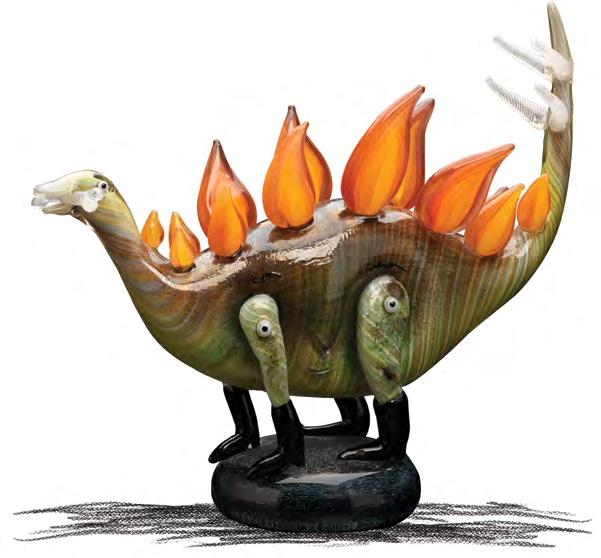
It does not make a lot of sense - they were vegetarians.
Perhaps this one is playing fetch.
It is generally accepted that the plates on the spines of stegosauruses served the function of regulating heat.
This one seems cheerful enough with the plates blazing.
There is no evidence that these creatures wore such dapper boots.
There is something curious about using fossil fuel to make dinosaurs.
This guy wonders about the lives of the creatures that have empowered our modern marvels, including the production of objects such as himself.

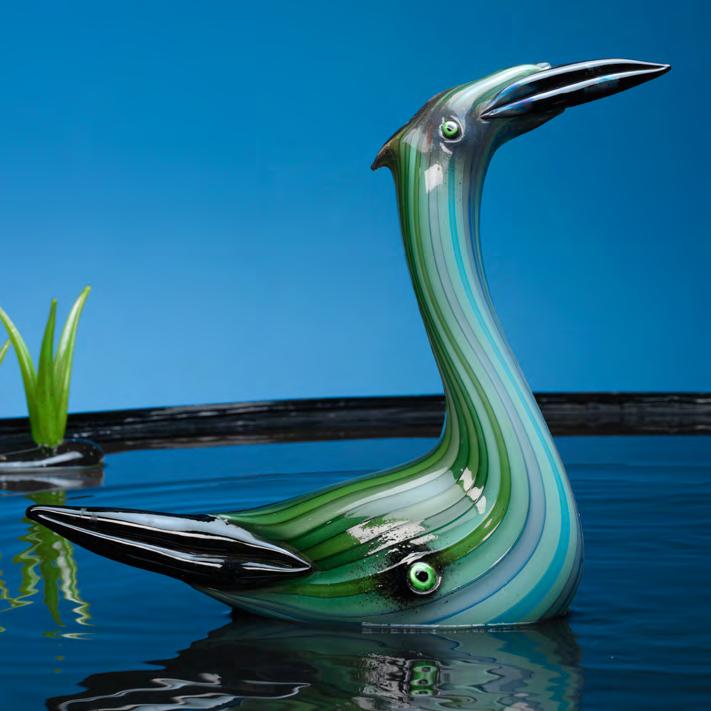
emordnilaP is palindrome reversed. Palndrome emordnilaP is a palindrome.
Palindrome birds are an embodiment of the idea of the world turned upside down, taken to the extreme.
Here there is no wrong way up. Maybe they are the true inheritors of zero gravity?
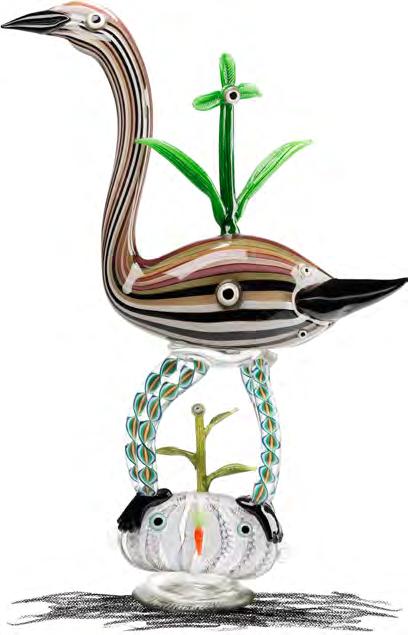
This sightless motor is so envious of its more evolved eyeballed cousins that it has overcompensated by becoming a rancorous predator, hoarding gold and trees.
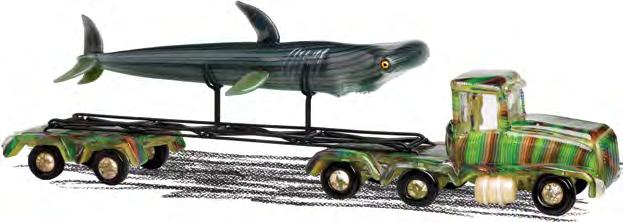
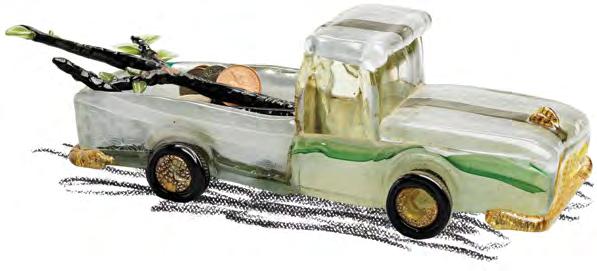
Moore’s research has not been limited to those working in similarly absurd creative fields however. He has also delved into humour theory; it would seem nothing about Moore’s practice should be accidental – not the creation of his creatures which are based on measured drawings, or even the quality of engagement with his audience through the power of laughter.

Moore cites contemporary philosopher John Morreall, who contends that humour is one of seven aesthetic categories capable of producing pleasant cognitive shifts in the viewer. Given the dire environmental message Moore is alerting his audience to, it’s an incredible feat that he is able to do so while keeping a smile on their face. A spoonful of sugar helps the medicine go down, it would seem!
Through his assemblage of pickle people, potato cars and two-headed birds (amongst many other interesting creatures), Tom Moore provides us with a bridge between two worlds. He seduces us into the world of pure, unbridled, joyful imagination. He reminds us of what it’s like to enjoy things as a child would – to believe in the absurd, to laugh at nonsense, and to create stories and conversations on a whim.
The other world is the one we actually exist in; a world of frightening reality and increasingly devoid of ‘natural balance’. It’s amazing that it takes the impact of our choices on Moore’s characters – to see the uncertainty of their future – to truly appreciate the gravity of our own situation.
Eric Nash Curator, Gallery ServicesEndnotes
1. Well Made Profile Tom Moore, 2016. Film courtesy of Guildhouse by Colin Haynes
2. Tom Moore Artist’s Statement from Watching glass grow. Published by the Board of the Botanic Gardens and State Herbarium, Adelaide, Australia, 2016
3. Well Made Profile Tom Moore, 2016. Film courtesy of Guildhouse by Colin Haynes
4. Tom Moore quoted by Tony Kanellos 20/20 vision from Watching glass grow. Published by the Board of the Botanic Gardens and State Herbarium, Adelaide, Australia, 2016
5. Well Made Profile Tom Moore, 2016. Film courtesy of Guildhouse by Colin Haynes
6. Well Made Profile Tom Moore, 2016. Film courtesy of Guildhouse by Colin Haynes
7. Tom Moore Artist’s Statement from Watching glass grow. Published by the Board of the Botanic Gardens and State Herbarium, Adelaide, Australia, 2016
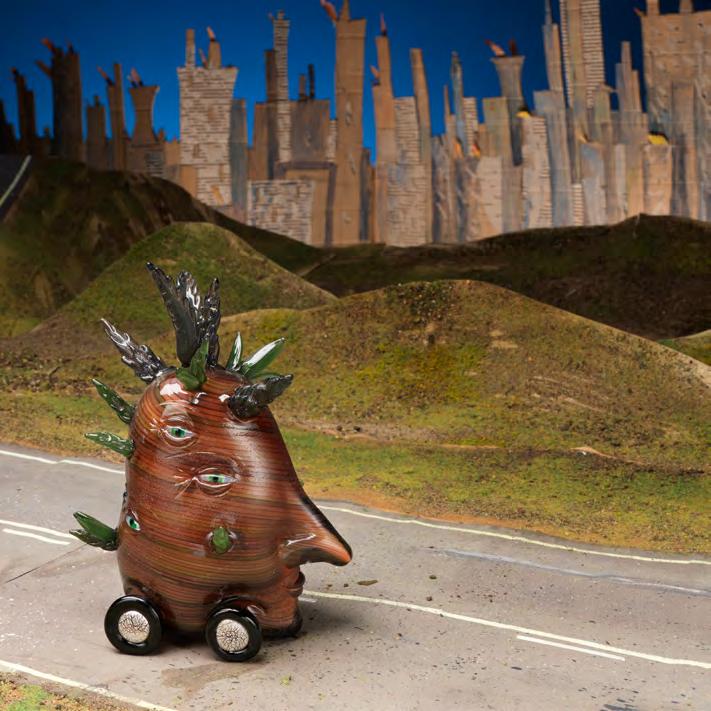
Desert Island Potato Car has evolved so far from those mythical travelling islands of yesteryear that it can emerge from the water, travel down a highway and plonk itself down wherever it chooses.

